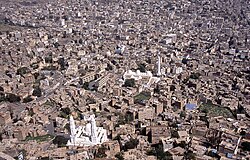The city is the administrative division which falls under the division of the directorate in the urban, which is the centre of the provinces and the centre of districts as well as every urban population with a population of (5,000) or more people and a basic service or more available.





Here is a list of cities in Yemen :
| Rank | Name | Population | Governorate | ||
|---|---|---|---|---|---|
| Transcription | Arabic | Census 1994 | Estimate 2005[ needs update ] | ||
| 1. | Sana'a | صنعاء | 954,448 | 2,431,649 | Sana'a (Capital District) |
| 2. | Ta'izz | تعز | 317,571 | 596,672 | Ta'izz |
| 3. | Al Hudaydah | الحديدة | 298,452 | 548,433 | Al Hudaydah |
| 4. | Aden | عدن | 398,294 | 507,355 | 'Adan |
| 5. | Ibb | إب | 103,312 | 225,611 | Ibb |
| 6. | Dhamar | ذمار | 82,920 | 160,114 | Dhamar |
| 7. | Mukalla | المكلا | 122,359 | 144,137 | Hadhramaut |
| 8. | Seiyun | سيئون | 111,728 | 120,137 | Hadhramaut |
| 9. | Zinjibar | (زنجبار (أبين | 50,346 | 70,801 | Abyan |
| 10. | Sayyan | سيان | 58,383 | 69,993 | San‘a’ |
| 11. | Ash Shihr | الشحر | 48,577 | 68,313 | Hadhramaut |
| 12. | Sahar | سحار | 27,621 | 60,487 | San‘a’ |
| 13. | Sa'ada | صعدة | ? | 51,870 | Sa'ada |
| 14. | Zabid | زبيد | 44,239 | 50,781 | Al Hudaydah |
| 15. | Hajjah | حجة | 24,645 | 46,568 | Hajjah |
| 16. | Bajil District | باجل | 40,561 | 46,005 | Al Hudaydah |
| 17. | Dhi as-Sufal | ذي سفال | 31,963 | 44,949 | Ibb |
| 18. | Rada'a | رداع | 39,227 | 44,755 | Al Bayda' |
| 19. | Bait al-Faqih | بيت الفقيه | 28,773 | 41,652 | Al Hudaydah |
| 20. | al-Marawi'a | المراوعة | 30,504 | 39,911 | Al Hudaydah |
| 21. | Yarim | يريم | 27,802 | 34,805 | Ibb |
| 22. | Al Bayda' | البيضاء | 19,294 | 33,175 | Al Bayda' |
| 23. | 'Amran | عمران | 28,212 | 31,497 | San‘a’ |
| 24. | Lahij | لحج | 19,006 | 26,728 | Lahij |
| 25. | Abs | عبس | 18,320 | 25,763 | Hajjah |
| 26. | Harad | حرض | 15,710 | 22,093 | Hajjah |
| 27. | Dimnat Chadir | 15,651 | 22,010 | Ta'izz | |
| 28. | Ataq | عتق | 13,995 | 19,681 | Shabwah |
| 29. | al-Mahabischa | المحابشة | 12,918 | 18,166 | Hajjah |
| 30. | Baihan | بيحان | 12,685 | 17,839 | Shabwah |
| 31. | Marib | مأرب | 6,996 | 16,794 | Ma'rib |
| 32. | Thula | ثلاء | 11,564 | 16,262 | 'Amran |
| 33. | Az Zaydiyah | الزيدية | 13,912 | 16,246 | Al Hudaydah |
| 34. | Mudiyah | مودية | 11,071 | 15,569 | Abyan |
| 35. | Khamir | خمر | 10,903 | 15,333 | 'Amran |
| 36. | Hais | حيس | 10,678 | 15,016 | Ta'izz |
| 37. | ad-Dahi | الضحى | 10,496 | 14,760 | Al Hudaydah |
| 38. | Mocha | المخا | 10,355 | 14,562 | Ta'izz |
| 39. | Al Ghaydah | الغيضة | 7,785 | 10,948 | Al Mahrah |
| 40. | Al Mahwit | المحويت | 9,060 | 10,593 | Al Mahwit |